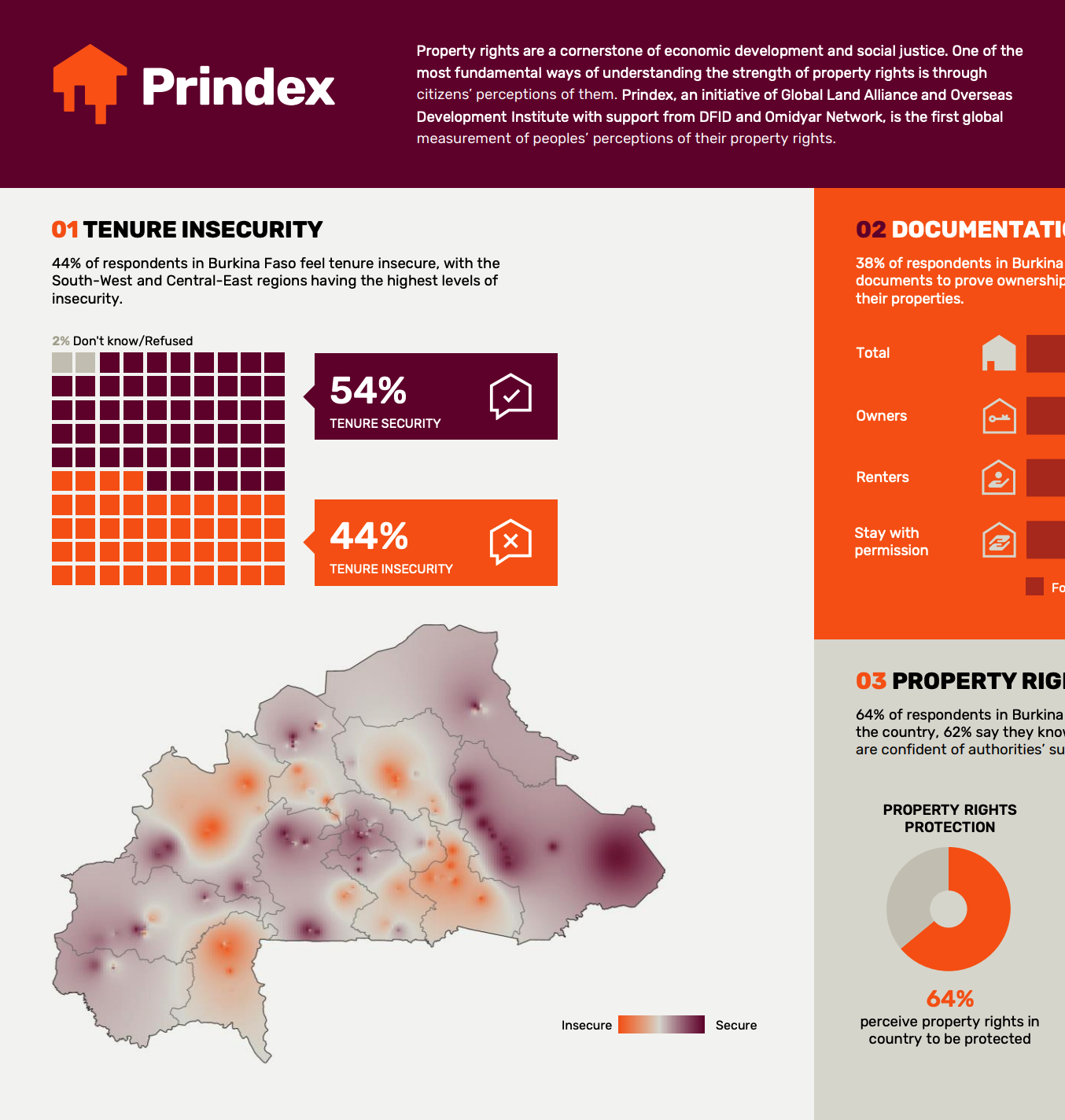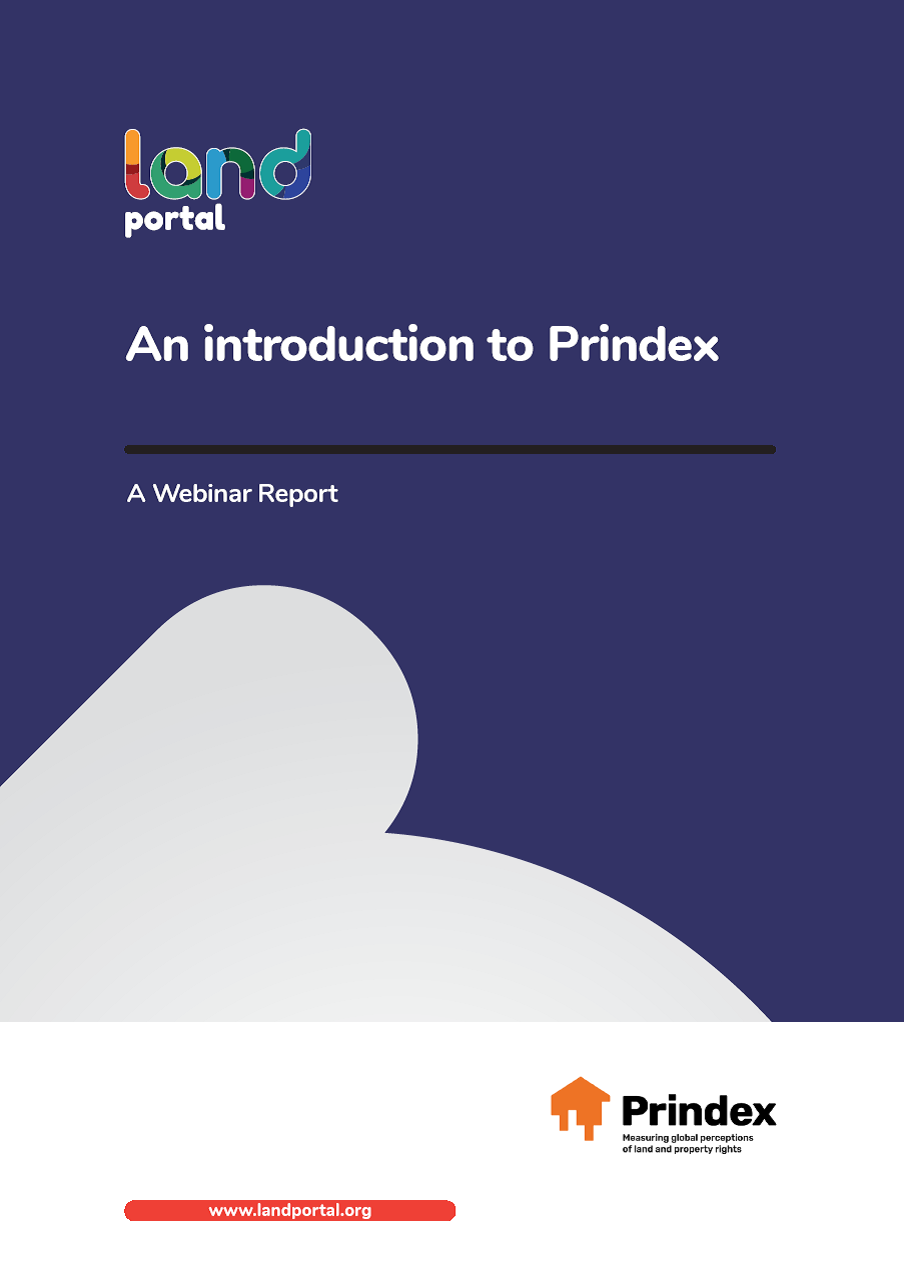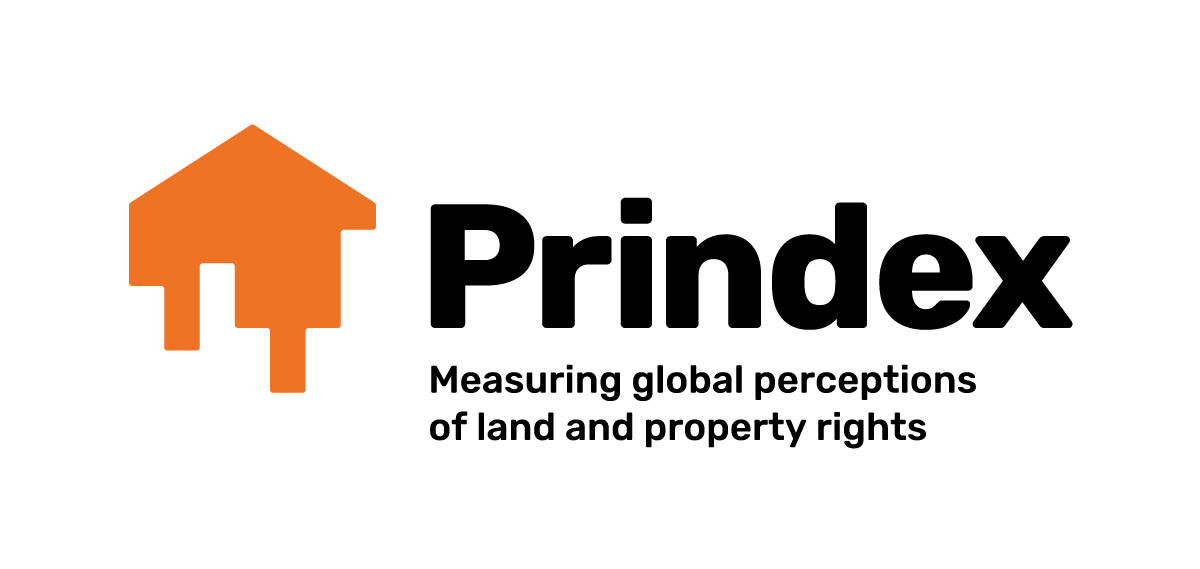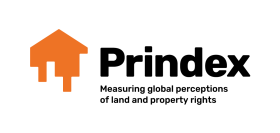
Prindex stands for the Global Property Rights Index, an indicator of citizens' perceptions of the security of land and property rights. It aims to fill the gap in information about individual perception of tenure security, by creating a baseline global dataset covering more than 100 countries by the end of 2019, to support the achievement of secure property rights around the world.
This dataset portfolio shows a selection of the key 2018-2019 Prindex indicators for 33 countries (Benin, Bolivia, Burkina Faso, Cambodia, Cameroon, Colombia, Costa Rica, Ivory Coast, Ecuador, Ghana, Honduras, Indonesia, Jordan, Kenya, Liberia, Madagascar, Malawi, Mexico, Morocco, Mozambique, Namibia, Niger, Nigeria, Peru, Rwanda, Senegal, Tanzania, Thailand, Tunisia, Uganda, United kingdom, Vietnam and Zambia) but additional information about the methodology and the questionnaire, as well as the full data are available on the Prindex website: https://www.prindex.net/.
Results from 33 countries shows that almost 1 in 4 people feel insecure about their land and property rights.

Source: Prindex Comparative Report, Figure A (p. 5,) March 2019.
Prindex is an initiative of ODI and Land Alliance supported by Omidyar Network, DFID and other donors.
Why does the Prindex matter?
Property rights are a cornerstone of economic development and social justice. Data on perceptions of security of property rights are required to monitor global initiatives such as the Voluntary Guidelines on the Responsible Governance of Tenure of Land, Forests and Fisheries and the Sustainable Development Goals (see indicators 1.4.2 and 5.a.1).
However, perceptions of security of tenure have never been assessed at the global level, preventing a clear understanding of the magnitude and nature of citizens' experience of security and insecurity related to crucial assets such as housing and land. Prindex addresses this gap, creating a baseline global dataset to support the achievement of secure property rights around the world.
What is the status?
After an initial nine-country pilot in 2016-2017 and a second three-country test study in 2017, Prindex improved its methodology and released the data for the first set of 15 countries in September 2018 and for additional 18 countries in March 2019. Currently Prindex provides data for 33 countries and the plan is to cover more than 100 countries by the end of 2019.
Please note that the data collected during the pilot and test phases and the data currently being collected and released are not directly comparable. Indeed, building on the lessons learned from the pilots, the Prindex methodology has now been modified and improved.
What is the methodology?
The Prindex 2018 questionnaire (PDF) measures respondents’ tenure security by posing nearly 60 questions in six core modules. In line with the efforts to build a comparable indicator for tracking progress on tenure security in the land sector, Prindex assesses perceived tenure security via a central question about people’s home, land and / or additional property:
- In the next five years, how likely or unlikely is it that you could lose the right to use this property, or part of this property, against your will?
The survey also collect a range of additional data through the questionnaire designed to capture robust information on individuals’ tenure situation, as well as key individual and household characteristics.
Key areas of enquiry include information on tenure rights the respondents have over their main dwelling, respondents’ perceptions of their tenure, documentation of tenure rights, benefits conferred by tenure security, tenure rights to other properties and tenure security of these, and experience of tenure insecurity and perceptions of tenure security at a national level.
Additional information about the 2018 Prindex methodology are available on the Prindex website: https://www.prindex.net/data/methodology/
What are the main results?
The Prindex Comparative Report released in March 2019 provides data from nearly 53,000 individuals in 33 countries, representing a combined population of over 889 million adults. It is the largest dataset of its kind and includes the first high-income country in the Prindex sample, the United Kingdom. These findings tell us how secure people feel about their land and property rights in those countries, providing a launch pad for deepening and intensifying processes of policy review and reform around the world.
If conclusions and findings are often country specifics, it is also true that this report highlights that almost 1 in 4 people feel insecure about their land and property rights.
The full March 2019 comparative report can be downloaded and accessed at: https://www.prindex.net/reports/prindex-comparative-report-march-2019/. The key results at the country level are summarised in the following short infographics: https://www.prindex.net/reports/15-country-infographics/ (October 2018 wave - 15 countries) and https://www.prindex.net/reports/18-country-infographics/ (March 2019 wave - 18 countries).
Additional reports recently released use Prindex data to analyse more in depth women's perception on tenure security (https://www.prindex.net/reports/womens-perceptions-tenure-security-evidence-33-countries/) and urban land tenure security (https://www.prindex.net/reports/global-perceptions-urban-land-tenure-security-report-evidence-33-countries/).
Who is involved?
The Global Property Rights Index is an initiative of ODI and Land Alliance supported by Omidyar Network, DFID and other donors.
Selected indicators from Prindex 2018
Related content on the Land Portal
18 Country Infographics (Prindex)
Wave 2 country infographics in one document. Countries include: Benin, Bolivia, Cambodia, Colombia, Ghana, Indonesia, Jordan, Kenya, Malawi, Mexico, Morocco, Niger, Nigeria, Tanzania, Tunisia, Uganda, United Kingdom and Vietnam
Prindex Comparative Report, March 2019
Property rights are a cornerstone of economic development and social justice. A fundamental way of understanding the strength of property rights is through citizens' perceptions of them. Yet perceptions of tenure security have never been collected at a global scale.
Prindex - Global Property Rights Index - 2016 Pilot
PRIndex stands for the Global Property Rights Index, an indicator of citizens' perceptions of the security of property rights, and this page only displays the results of the first pilot and testing phase run in 2016-2017.
The pilot phase of development and testing of the index took place in nine countries (Brazil, Colombia, Egypt, Greece, India, Indonesia, Nigeria, Peru and Tanzania) during 2016 and 2017.
A second phase of data collection, using a new improved methodology and planned for 2018-2019, is currently on-going and new Prindex data for 15 countries are now available on https://www.prindex.net/data/.
Please note that the data collected during the pilot and the data collected during the second phase are not directly comparable, due to the improvements made to the Prindex methodology. A selection of relevant indicators from the new Prindex data will soon be made available on the Land Portal too.
The Global Property Rights Index is an initiative of ODI and Land Alliance supported by Omidyar Network, DFID and other donors. It aims to fill the gap in information about individual perception of tenure security by creating a baseline global dataset to support the achievement of secure property rights around the world.
PRIndex: Interactive indicators
Rate of property documentation
The PRIndex dataset presented here contains indicators based on the pilot survey data collected in 8 countries with nationally representative samples.
Three Cheers for the Gender-Inclusive Prindex Report
I have talked to women in at least 15 countries—in their homes, their gardens, their fields, their pastures, their universities, their community organizations, their government and executive offices, and their courtrooms. When asked about rural women’s land use or rights or ownership or livelihood, the thing that usually stands out to me is that most women say, in one form or another, that rural women are generally able to use land, and sometimes even control land, when they are in an intact family.
Prindex Comparative Report, October 2018
Property rights are a cornerstone of economic development and social justice. A fundamental way of understanding the strength of property rights is through citizens' perceptions of them. Yet perceptions of tenure security have never been collected at a global scale.
Global perceptions of urban land tenure security report
A deeper look at what the results of the 33 wave 1 and 2 countries show about urban land tenure security. This report compliments the Prindex Comparative Report by focusing on a specific aspect of land and tenure insecurity.
A visit to displaced communities in north Honduras reminded me why we need Prindex
Malcolm Childress visited Honduras in April as part of a fact-finding and speaking delegation sponsored by the US State Department.
On the northern coast of Honduras, palm forests give way to white sands, blue seas and one of the world’s most spectacular coral reefs. But, in a story that will be familiar to observers of land rights worldwide, that beauty has brought developers eager to build, and conflict around the ownership of land occupied and claimed by longstanding Garifuna communities.
15 Country Infographics
Wave 1 country infographics in one document. Countries include: Burkina Faso, Cameroon, Costa Rica, Cote D'Ivoire, Ecuador, Honduras, Liberia, Madagascar, Mozambique, Namibia, Peru, Rwanda, Senegal, Thailand, Zambia.
Women's perceptions of tenure security
This report uses household-level data from 33, mostly developing, countries to analyse perceptions of tenure insecurity among women. We test two hypotheses: (1) that women feel more insecure than men; and (2) that increasing statutory protections for women, for instance by issuing joint named titles or making inheritance law more gender equal, increases de facto tenure security.
An Introduction to Prindex
The webinar An introduction to Prindex took place on 28 November, 2018. This webinar presented a basic understanding of how Prindex works. The Prindex team presented results of data collected from 15 countries. It focused on pathways for using Prindex to propel policy conversations and movement-building for policy reform with the help of panellists from some of the countries where data was collected.
Panelists were asked to address the following questions:
Download
Get all Prindex 2019 country data (100MBs)
Access the Prindex questionnaire and the code book.















